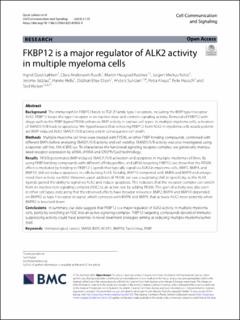| dc.contributor.author | Quist-Løkken, Ingrid | |
| dc.contributor.author | Andersson-Rusch, Clara Leticia | |
| dc.contributor.author | Kastnes, Martin Haugrud | |
| dc.contributor.author | Jürgen Markus Kolos, , Jürgen Markus | |
| dc.contributor.author | Jatzlau, Jerome | |
| dc.contributor.author | Hella, Hanne | |
| dc.contributor.author | Olsen, Oddrun Elise | |
| dc.contributor.author | Sundan, Anders | |
| dc.contributor.author | Knaus, Petra | |
| dc.contributor.author | Hausch, Felix | |
| dc.contributor.author | Holien, Toril | |
| dc.date.accessioned | 2023-10-24T09:21:03Z | |
| dc.date.available | 2023-10-24T09:21:03Z | |
| dc.date.created | 2023-02-13T09:34:08Z | |
| dc.date.issued | 2023 | |
| dc.identifier.citation | Cell Commun Signal 21, 25 (2023). | en_US |
| dc.identifier.issn | 1478-811X | |
| dc.identifier.uri | https://hdl.handle.net/11250/3098301 | |
| dc.description.abstract | Background: The immunophilin FKBP12 binds to TGF-β family type I receptors, including the BMP type I receptor ALK2. FKBP12 keeps the type I receptor in an inactive state and controls signaling activity. Removal of FKBP12 with drugs such as the FKBP-ligand FK506 enhances BMP activity in various cell types. In multiple myeloma cells, activation of SMAD1/5/8 leads to apoptosis. We hypothesized that removing FKBP12 from ALK2 in myeloma cells would potentiate BMP-induced ALK2-SMAD1/5/8 activity and in consequence cell death.
Methods: Multiple myeloma cell lines were treated with FK506, or other FKBP-binding compounds, combined with different BMPs before analyzing SMAD1/5/8 activity and cell viability. SMAD1/5/8 activity was also investigated using a reporter cell line, INA-6 BRE-luc. To characterize the functional signaling receptor complex, we genetically manipulated receptor expression by siRNA, shRNA and CRISPR/Cas9 technology.
Results: FK506 potentiated BMP-induced SMAD1/5/8 activation and apoptosis in multiple myeloma cell lines. By using FKBP-binding compounds with different affinity profiles, and siRNA targeting FKBP12, we show that the FK506 effect is mediated by binding to FKBP12. Ligands that typically signal via ALK3 in myeloma cells, BMP2, BMP4, and BMP10, did not induce apoptosis in cells lacking ALK3. Notably, BMP10 competed with BMP6 and BMP9 and antagonized their activity via ALK2. However, upon addition of FK506, we saw a surprising shift in specificity, as the ALK3 ligands gained the ability to signal via ALK2 and induce apoptosis. This indicates that the receptor complex can switch from an inactive non-signaling complex (NSC) to an active one by adding FK506. This gain of activity was also seen in other cell types, indicating that the observed effects have broader relevance. BMP2, BMP4 and BMP10 depended on BMPR2 as type II receptor to signal, which contrasts with BMP6 and BMP9, that activate ALK2 more potently when BMPR2 is knocked down.
Conclusions: In summary, our data suggest that FKBP12 is a major regulator of ALK2 activity in multiple myeloma cells, partly by switching an NSC into an active signaling complex. FKBP12 targeting compounds devoid of immunosuppressing activity could have potential in novel treatment strategies aiming at reducing multiple myeloma tumor load. | |
| dc.language.iso | eng | en_US |
| dc.publisher | BMC | en_US |
| dc.rights | Navngivelse 4.0 Internasjonal | * |
| dc.rights.uri | http://creativecommons.org/licenses/by/4.0/deed.no | * |
| dc.title | FKBP12 is a major regulator of ALK2 activity in multiple myeloma cells | en_US |
| dc.title.alternative | FKBP12 is a major regulator of ALK2 activity in multiple myeloma cells | en_US |
| dc.type | Journal article | en_US |
| dc.type | Peer reviewed | en_US |
| dc.description.version | publishedVersion | en_US |
| dc.source.volume | 21 | en_US |
| dc.source.journal | Cell Communication and Signaling | en_US |
| dc.source.issue | 1 | en_US |
| dc.identifier.doi | 10.1186/s12964-022-01033-9 | |
| dc.identifier.cristin | 2125411 | |
| cristin.ispublished | true | |
| cristin.fulltext | original | |
| cristin.qualitycode | 1 | |

